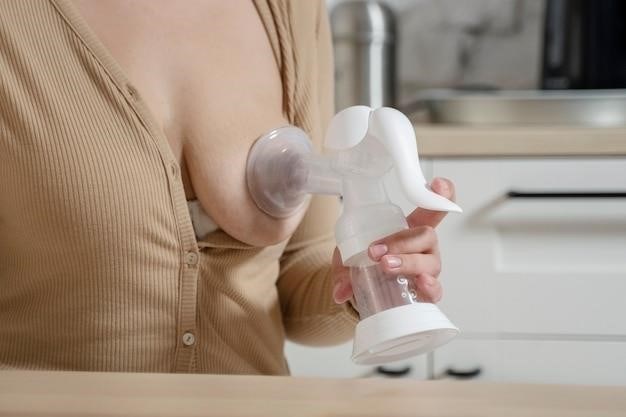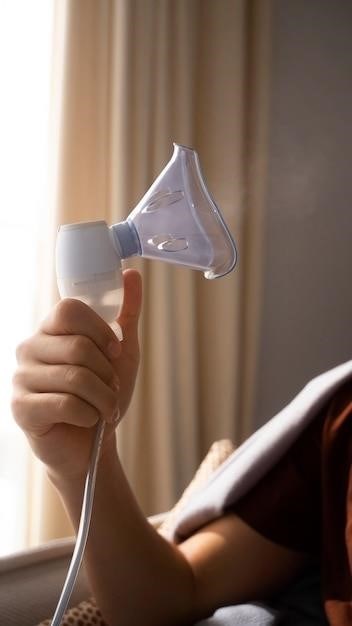Manual vs. Electric Breast Pumps⁚ A Comprehensive Comparison
This comparison explores the key differences between manual and electric breast pumps, considering factors like cost, portability, pumping efficiency, features, ease of use, suction, noise levels, and long-term durability to help you choose the best option for your needs.
Cost and Affordability
A significant difference between manual and electric breast pumps lies in their cost. Manual pumps are typically much cheaper, often costing less than $30, making them a budget-friendly option for mothers who only need to pump occasionally or have limited budgets. Electric pumps, on the other hand, represent a more substantial investment. Prices vary greatly depending on features and brand, ranging from a few hundred dollars for basic models to well over $300 for those with advanced features like multiple settings and double pumping capabilities. The initial cost difference is considerable. However, the long-term cost-effectiveness depends on individual pumping frequency and needs. Frequent pumping necessitates more frequent replacement parts for both types, potentially offsetting some of the initial cost savings associated with manual pumps.

Portability and Convenience
Portability is a key factor differentiating manual and electric breast pumps. Manual pumps are significantly more portable due to their compact size and lack of electrical dependency. They can easily fit into a diaper bag or purse, allowing mothers to pump discreetly and conveniently in various locations. This portability is particularly beneficial for mothers on the go or those who prefer flexibility in their pumping routine. Electric pumps, while offering greater efficiency, are generally bulkier and require a power source, limiting their portability. They are typically best suited for use at home or in locations with readily available power outlets. While some electric pumps offer battery options, these often add to the overall cost and may not provide the same level of sustained power as a wall outlet. The convenience of each type, therefore, is largely determined by the mother’s individual lifestyle and pumping needs.
Pumping Frequency and Efficiency
The frequency of pumping and the desired efficiency significantly influence the choice between manual and electric breast pumps. Electric pumps generally excel in efficiency, particularly for mothers who need to pump frequently or express large volumes of milk. Their motor-driven suction provides a consistent and often faster milk extraction, making them ideal for mothers of multiples or those with demanding schedules. The ability to adjust suction levels and pumping speeds further enhances their efficiency, allowing for personalized comfort and optimized milk flow. Manual pumps, while requiring more effort from the user, are suitable for occasional pumping or mothers who prioritize a gentler approach. They are often preferred for infrequent sessions or for supplementing breastfeeding, offering a more hands-on experience. The choice between the two depends largely on the individual’s pumping needs and preferences, with electric pumps offering superior speed and efficiency for frequent pumping and manual pumps offering a more controlled, less intense experience for less frequent use.
Features and Functionality
Electric breast pumps generally boast a wider array of features compared to their manual counterparts. Many electric models offer adjustable suction levels, allowing mothers to customize the pumping experience to their comfort and needs. Some also include multiple pumping modes, such as stimulation and expression modes, mimicking the natural suckling pattern of a baby to enhance milk flow. Additional features like timers, memory settings, and even night lights are commonly found in electric pumps, adding to their convenience. Closed-system pumps, which minimize the risk of bacterial contamination, are also more prevalent among electric models. Manual pumps, on the other hand, typically offer a more basic design, focusing primarily on simple, effective milk extraction. While some manual pumps may include features like different flange sizes or ergonomic handles to improve comfort, they generally lack the advanced functionalities of electric pumps. The choice depends on the user’s needs and preferences. If a mother requires advanced features and settings for efficient pumping, an electric pump is preferable. If simplicity and portability are prioritized, a manual pump may suffice.
Ease of Use and Cleaning
The ease of use differs significantly between manual and electric breast pumps. Electric pumps, with their motorized suction, generally require less physical effort from the user. The pumping process is largely automated, requiring minimal hand movement beyond adjusting settings or pausing the pump. However, the numerous parts of an electric pump can make cleaning more complex and time-consuming. Disassembling, washing, and sterilizing all components thoroughly is crucial for hygiene. Manual pumps, conversely, are simpler to use, requiring the user to manually create suction by squeezing a handle. This provides greater control over suction strength and rhythm, but can cause hand fatigue with prolonged use. Cleaning a manual pump is typically easier, as it usually involves fewer parts. The simpler design and fewer components mean quicker cleaning and sterilization. The choice between the two depends on individual preferences and priorities. Mothers prioritizing convenience might find electric pumps easier despite the cleaning complexity, while those valuing simplicity and ease of cleaning might prefer manual pumps, even if it requires more physical effort during pumping.
Suction and Comfort Levels
Suction strength and comfort levels vary considerably between manual and electric breast pumps. Electric pumps often offer adjustable suction settings, allowing mothers to customize the intensity to their comfort level. This adjustability caters to individual sensitivities and varying milk ejection reflexes. However, the powerful suction of some electric pumps can be uncomfortable for some mothers, potentially leading to nipple soreness or damage if not properly adjusted. Manual pumps, on the other hand, usually provide a gentler suction, allowing for more precise control over the suction strength. This can be advantageous for mothers with sensitive nipples or those who prefer a more gradual milk expression. The level of comfort also depends on the fit of the pump flange; improperly sized flanges can cause discomfort in both electric and manual pumps. Many mothers find that the ability to adjust suction in electric pumps ultimately contributes to a more comfortable pumping experience, while others prefer the gentler, more controlled suction of manual pumps. Ultimately, the optimal suction and comfort levels are subjective and depend on individual preferences and physical responses.

Noise Levels
Noise levels represent a significant difference between manual and electric breast pumps. Manual breast pumps are virtually silent, making them ideal for discreet pumping in various settings, including public places or shared spaces where noise could be disruptive. Their quiet operation allows for a more peaceful and relaxing pumping experience, without disturbing others or creating a distracting environment. In contrast, electric breast pumps generate varying levels of noise depending on the model and settings. Some electric pumps produce a noticeable humming or whirring sound during operation, potentially disrupting sleep or concentration, especially in quiet environments. The noise level can also impact the overall comfort and convenience of pumping, particularly for mothers who prefer a calm and quiet atmosphere. The noise produced by electric pumps can range from a low hum to a more pronounced whirring sound; the intensity varies between different brands and models. Therefore, mothers considering an electric pump should research noise levels before purchasing to ensure the sound level aligns with their preferences and needs.
Long-Term Use and Durability
The long-term use and durability of breast pumps vary significantly depending on the type and brand. Manual pumps, due to their simpler mechanics, often boast remarkable longevity. With proper cleaning and care, a high-quality manual pump can serve a mother for multiple children, lasting for years. However, the repetitive hand movements required can lead to hand fatigue, potentially limiting extended pumping sessions, especially for mothers who need to pump frequently. Electric breast pumps, on the other hand, offer convenience and speed but might have a shorter lifespan. The motor and electronic components are subject to wear and tear, potentially leading to malfunctions or reduced effectiveness over time. The durability of an electric pump is often dependent on the quality of the build and the care taken during use and cleaning. Regular maintenance and adherence to manufacturer recommendations for cleaning and storage can significantly extend the life of both types of pumps. Ultimately, the choice between a manual and electric pump depends not only on immediate needs but also on long-term considerations of durability and the user’s physical capabilities.
Overall Considerations and Recommendations
Selecting between a manual and electric breast pump is a deeply personal decision, heavily influenced by individual needs and circumstances. Mothers who pump infrequently, prioritize portability, and have a tighter budget might find a manual pump perfectly suitable. The lower cost and compact size make them ideal for occasional use or travel. However, for mothers who require frequent and extended pumping sessions, an electric pump offers superior efficiency and reduced physical strain. The ability to double pump significantly increases milk expression in less time. Factors such as milk supply, baby’s feeding schedule, and the mother’s lifestyle all play crucial roles in this decision; Consider consulting a lactation consultant who can provide personalized recommendations based on your unique situation. They can help assess your pumping needs and guide you toward the best choice to support your breastfeeding journey effectively and comfortably. Ultimately, the ‘best’ pump is the one that best meets your individual needs and enhances your breastfeeding experience.
